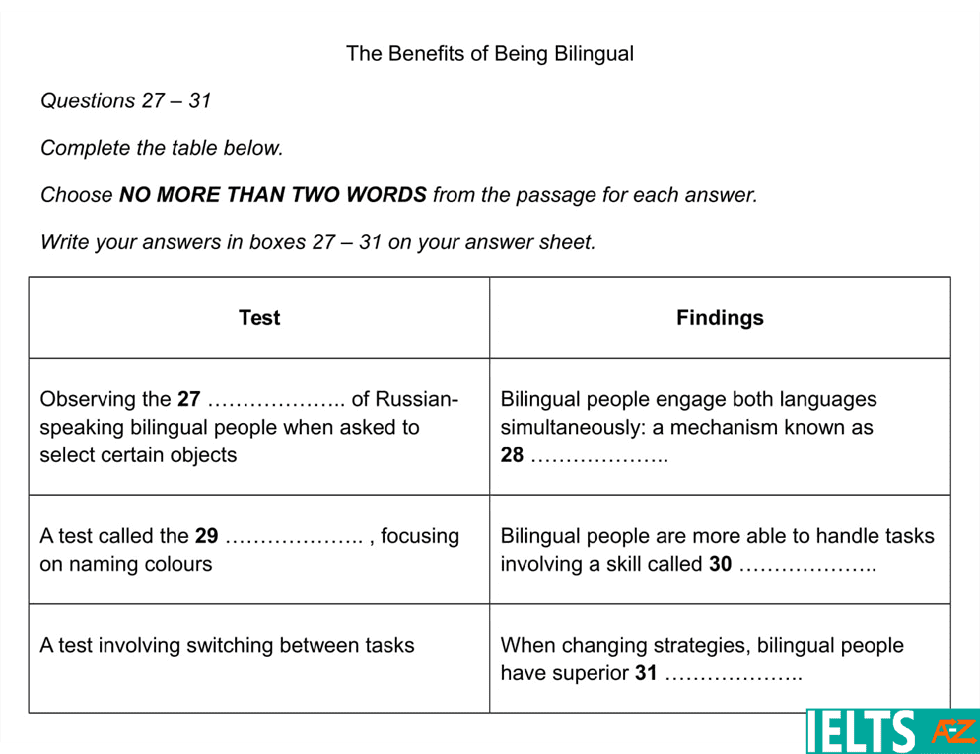Table Completion
On this page, we will learn about: What is Table Completion?, Example of Table Completion, Strategies to Answer the Table Completion Questions, Tips for Table Completion Questions, and IELTS Table Completion Practice Exercise, Answer, and Explanation.
What is Table Completion?
A table is a way to categorize information that is described in a text. In IELTS Reading, the table completion question will involve filling in the gaps using words that are taken directly from the text.
You can find the number of words that you need to fill in the instructions. Even if your answer is correct, using the wrong number of words would lead to a loss of marks.
Example of Table Completion:

Strategies to answer the table completion questions:
- Read all of the instructions carefully. Even a minor mistake can cost you marks. Be careful about the words you use to fill the gaps.
- Understanding the table's layout to know the content and the subject.
- Quickly go through the questions and passages to get the main idea and what kind of information would have to fill in the gaps.
- To find the information, navigate through the paragraphs and write down keywords and ideas next to every paragraph.
- Go to the questions and select the best keywords, and then try to find them in the passage.
- Remember, you will also get some paraphrased sentences and synonyms. So, you must check the word limit while answering these.
Tips for Table Completion questions:
- Make use of a step-by-step approach that streamlines the questions of table completion.
- Do not panic while giving the exam if you find anything unfamiliar; try solving questions using a step-by-step strategy.
- The order of questions could be different from the given information in the reading passage.
- While answering the question , avoid using synonyms. If you do not fill in the gaps with all of the right words, the answers will be marked as incorrect.
- Identify the word type that is missing in the answer, whether it is an adjective, an adverb, a verb, or a noun. Finding the right word will be much easier.
- Instead of finding the exact word, try to find the matching meaning .
- First, find the location, then figure out the details in the passage.
- The sentence should be grammatically correct.
This is what the Table Completion question may look like on the IELTS Reading test:
IELTS Table Completion Practice Exercise:
By the early nineteenth century - the start of the railway age—men such as John McAdam and Thomas Telford had built a British road network totaling some 200,000 km, of which about one sixth was privately owned toll roads known as turnpikes. In the first half of the nineteenth century, many roads in the United States were built to the new standards, the most notable of which was the National Pike from West Virginia to Illinois.
In the twentieth century, the ever-increasing use of motor vehicles threatened to destabilize roads built to nineteenth-century standards, so new techniques had to be developed. On routes with heavy traffic, flexible pavements were modified by rigid pavements, in which the top layer was concrete, 15 to 30 centimeters thick, laid on a prepared bed.
Nowadays, steel bars are embedded within the concrete. This not only restrains shrinkage during setting but also minimizes expansion in warm temperatures. As a result, it is possible to lay long slabs without the danger of cracking.
Questions:
Complete the table below.
Use ONE WORD ONLY from the passage for each answer.
| Time period | Type of roads |
|---|---|
| Early 19th century | Turn pikes also known as 1……… roads |
| First half of the 2………………. century | National Pike |
| 20th century | flexible pavements were modified by 3…………. pavements |
| Now | 4……… bars are embedded within the concrete |
Answers
| Time period | Type of roads |
|---|---|
| Early 19th century | Turn pikes also known as 1. toll roads |
| First half of the 2. nineteenth century | National Pike |
| 20th century | flexible pavements were modified by 3. rigid pavements |
| Now | 4. steel bars are embedded within the concrete |
Explanations:
1. If we look at the first sentence of the first paragraph
" By the early nineteenth century - the start of the railway age—men such as John McAdam and Thomas Telford had built a British road network totaling some 200,000 km, of which about one sixth was privately owned toll roads known as turnpikes."
here, the keywords are Early 19th century and roads.
So,the correct answer is toll.
2. If we look at the second sentence of the first paragraph
" In the first half of the nineteenth century, many roads in the United States were built to the new standards, the most notable of which was the National Pike from West Virginia to Illinois."
here, the keywords is National Pike and the gap is required a number.
So,the correct answer is nineteenth.
3. If we look at the second sentence of the second paragraph
" On routes with heavy traffic, flexible pavements were modified by rigid pavements, in which the top layer was concrete, 15 to 30 centimeters thick, laid on a prepared bed."
here, the keywords are 20th century and If we see carefully the gap required a "noun" after the preposition "by".
So,the correct answer is rigid.
4. In the last paragraph, the text is mentioned about present time.
" Nowadays, steel bars are embedded within the concrete."
So,the correct answer is steel.